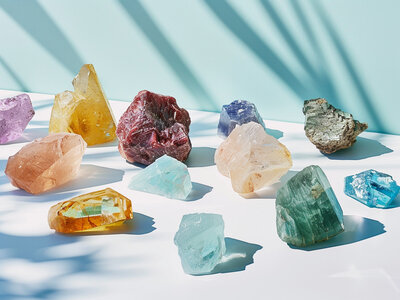Uncut gemstones, also known as rough or raw gemstones, are nature's unrefined treasures, brimming with untapped potential and hidden beauty. From their origins deep within the earth to their journey into the hands of skilled lapidaries, uncut gemstones hold a world of wonder waiting to be discovered. Let's delve into 10 fascinating facts about these captivating gems:
- Natural Form: Uncut gemstones are minerals that have been extracted from the earth in their raw, unaltered state. Unlike their polished counterparts, uncut gemstones retain their natural shape, texture, and surface features, offering a glimpse into the geological forces that shaped them.
- Diverse Origins: Uncut gemstones are found in a wide range of geological environments, including igneous, metamorphic, and sedimentary rock formations. Each type of environment produces unique gemstone varieties, from fiery opals formed in volcanic ash to sparkling diamonds forged deep within the earth's mantle.
- Variety of Colors: Uncut gemstones exhibit a dazzling array of colors, from the vivid blues of sapphires to the rich greens of emeralds and the fiery reds of rubies. These vibrant hues are the result of trace elements and impurities present in the crystal lattice of the gemstone.
- Crystal Structures: Uncut gemstones possess distinctive crystal structures that influence their physical properties, such as hardness, cleavage, and refractive index. These structural characteristics play a crucial role in determining how a gemstone is cut, polished, and ultimately transformed into a finished gem.
- Inclusions and Features: Uncut gemstones often contain inclusions, or internal features, that provide valuable insights into their formation history. These inclusions can include mineral crystals, gas bubbles, and other materials trapped within the gemstone during its growth process.
- Rarity and Value: Uncut gemstones are prized for their rarity, unique characteristics, and potential for transformation into exquisite jewelry pieces. While uncut gemstones may command lower prices than their polished counterparts, certain varieties and exceptional specimens can still fetch significant value in the market.
- Lapidary Artistry: Uncut gemstones undergo a meticulous process of cutting, shaping, and polishing by skilled artisans known as lapidaries. This transformative process reveals the gemstone's inner beauty, enhancing its color, clarity, and brilliance.
- Collector's Appeal: Uncut gemstones hold a special allure for collectors and enthusiasts who appreciate their natural beauty and unadulterated charm. Collectors often seek out rare and unusual specimens, such as large crystals, unique crystal formations, and gemstones with exceptional clarity or color.
- Ethical Sourcing: With growing concerns about ethical and sustainable practices in the gemstone industry, there is increasing demand for responsibly sourced uncut gemstones. Companies and artisans are adopting transparent sourcing practices to ensure that their gemstones are ethically mined and traded, benefiting local communities and preserving the environment.
- Connection to Nature: Uncut gemstones serve as a tangible connection to the natural world, reminding us of the earth's geological history, its transformative forces, and the beauty that lies beneath the surface. Whether displayed as specimens, incorporated into jewelry designs, or cherished as collectibles, uncut gemstones continue to captivate and inspire admirers around the globe.
In conclusion, uncut gemstones are not merely rough rocks waiting to be polished; they are symbols of nature's raw beauty, diversity, and resilience. From their origins deep within the earth to their journey into the hands of lapidaries and collectors, uncut gemstones carry with them a story of geological wonder and human ingenuity. As we marvel at their vibrant colors, unique features, and timeless allure, let us also appreciate the importance of ethical sourcing and responsible stewardship in preserving these precious treasures for generations to come.





